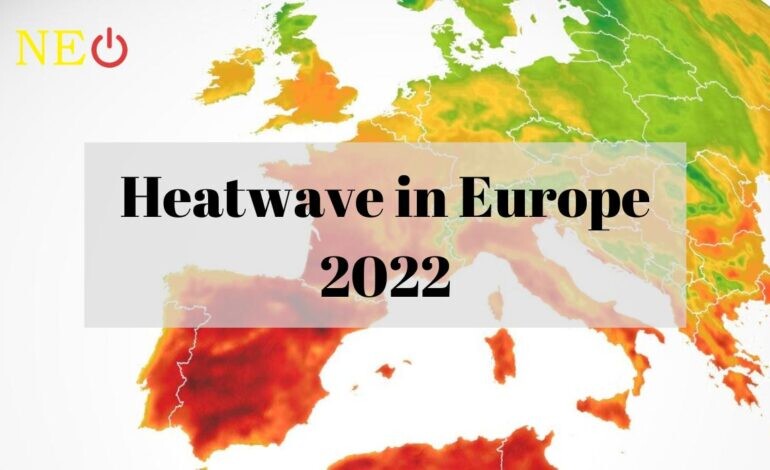Delhi air pollution
Delhi air quality remains 'very poor', anti-pollution restrictions imposed

France had its hottest May on record two months prior, with record high temperatures in some cities. A spring heat wave that also hit Spain, Italy, and other nations last month left France with blisters. Then, this month, a period of extreme heat caused problems in Poland and other parts of Eastern Europe.
Now, from Spain to the British Isles and moving east, temperatures are rising dramatically across Europe once more. Many nations are experiencing wildfires that have been sparked by the heat, and much of the continent is currently experiencing a protracted drought.
(At London's Heathrow airport, on July 19, the UK recorded its highest temperature ever, going past 40 degrees Celsius for the first time.)
Table of contents [Show]
Because temperatures today are generally about 1.1 degrees Celsius higher than they were in the late 19th century, before emissions of carbon dioxide and other heat-trapping gases became common, global warming plays a part in heat waves around the world. Therefore, extreme heat begins at a higher altitude, that circles the planet at high altitudes.
The UK will experience 40 °C for the first time this year. The UK's current record high temperature is 38.7°C, which was attained on July 25, 2019, at Cambridge Botanic Garden.
To quantify the likelihood of an event occurring and estimate the uncertainty that is always present in weather forecasting to some extent, weather forecast models are repeatedly run. For the beginning of next week, some models are currently predicting a 50% chance of maximum temperatures in some isolated parts of the UK exceeding 40°C. More people will experience temperatures in the mid- to high-30s Celsius range, and there is an 80% chance that we will break the record.
There is no such thing as a typical heat wave. A region of upper level low-pressure air that has been stuck off the coast of Portugal for days contributed to the sweltering temperatures that reached into England and Wales. In the jargon of atmospheric scientists, it is referred to as a "cut off low" because it was isolated from the mid-latitude jet stream, a river of westerly winds that circles the planet at great altitudes.


We had hoped we wouldn't reach this point, but Dr. Nikos Christidis, a climate scientist at the Met Office, said that for the first time ever, temperatures in the UK are expected to rise above 40°C. According to a recent study, the probability of extremely hot days in the UK has been rising and will do so for the rest of the century.
"Climate change has already affected how likely it is that extreme temperatures will occur in the UK. The likelihood of 40°C days in the UK could be up to 10 times higher in the current climate than in a naturally occurring climate free from human influence.


Europe has warmed by nearly twice the global average of 1.1 degrees Celsius, and is currently 1.94 to 1.99 degrees Celsius hotter than the preindustrial average. Temperatures during recent heat waves in Europe were three to five degrees higher than they had been in the past.
Although some of this extra heat is captured by climate models, they underpredict the warming that is actually occurring in Europe.
We do not comprehend why the models did not account for the current temperature increase. Models predict that since about 100 years ago, extreme heat waves have increased by 1.5 to 2 degrees, but not by 4 degrees. So, it's truly exceptional.


The jet stream, a stream of swiftly moving air that circles the northern hemisphere from west to east, regulates the climate in Europe. Sometimes the jet stream divides in two, a phenomenon known as a double jet by scientists. Double jets are common, but it appears that climate change is causing them to occur more frequently and last longer. We showed that the increased frequency in this particular jet state can explain... the increase in heat waves here, especially for Western Europe, all of the "extra" heat not predicted by climate models for Western Europe can be accounted for by double jets. About 30% of the excess heat in Europe is accounted for by double jets.


It is important to note that heat waves can have other negative effects besides high temperatures, according to Lorenzo Labrador, Scientific Officer for the WMO's Global Atmosphere Watch Programme. The atmosphere's stability and stagnation act as a lid to trap pollutants, such as particulate matter, raising their concentrations near the surface. Deterioration of air quality and negative health effects follow, especially for vulnerable populations. Similarly, episodes of ozone formation near the surface, which has negative effects on people and plants, are encouraged by the abundance of sunshine, high concentrations of some atmospheric pollutants, and stable atmosphere.

While it's still too early to say whether a double jet was involved in this year's heat waves, the ongoing droughts in Europe were "very likely" a contributing factor in the July heat wave.
In order to protect against intense heat, moist soils
Less water evaporates through plants or directly from the soils when soils that are typically humid become drier. This process is known as evapotranspiration. Because evapotranspiration typically consumes a lot of energy, when it doesn't occur due to overly dry soils, this energy is used to warm the air.


AMOC transports deep, cold water south and warm, salty water north. The AMOC will slow as the climate warms, as predicted by climate models, and some researchers believe this is already happening.
"It's still not 100% sure … but there's actually a lot of evidence pointing at an AMOC slowdown over the last decades," climate physicist Levke Caesar of Maynooth University in Ireland said in a voicemail to VOA
The elderly are especially vulnerable to heat exhaustion and heatstroke during heat waves, which can be fatal. Over 166,000 people perished as a result of heat waves between 1998 and 2017, according to the World Health Organization. In summer 2020, oppressive temperatures alone claimed more than 2,500 lives in the UK.
Climate change is expected to increase the frequency and intensity of extremely hot weather, according to experts. According to a recent report by the World Weather Attribution, climate change increased the likelihood of this year's prolonged, deadly early heat in India and Pakistan by 30 times. Climate scientists anticipate that heat waves will become the "new normal".
Beyond the immediate danger to life, extreme temperatures can also have an effect on economies. According to Phys.org, prolonged periods of extreme heat can lead to an increase in hospital visits, a sharp decline in construction and agricultural productivity, decreased agricultural yields, and even direct damage to infrastructure.
According to The Conversation, employees are less productive in hot weather, even if they work indoors, and kids have trouble learning in extreme heat, which results in lower lifetime earnings that harm future economic growth. In fact, a 2018 study found that hot summers tend to slow the growth of the economies of US states. According to the data, annual growth declines by 0.15 to 0.25 percentage points for every 1 degree Fahrenheit increase in a state's mean summer temperature.
Some incredibly unsettling statistics are revealed when the impact of extremely hot weather on economies is examined in greater detail. For instance, the European Environment Agency (EEA) estimates that heat waves in 32 European countries cost up to $71 billion between 1980 and 2000, and that's before accounting for the deadly heat waves of the previous two decades.
According to the International Labour Organization (ILO), heat waves could result in a more than 2% reduction in global labour hours by 2030. According to Phys.org, that equates to 80 million full-time jobs at a cost of $2.4 trillion, which is nearly 10 times the 1995 figure.
Delhi air quality remains 'very poor', anti-pollution restrictions imposed
World Environment Health Day 2024 is on September 26, 2024, and recognizes the impact of environmental factors on human health.
This modern approach involves multiple generations living under one roof, creating a dynamic household that offers numerous benefits.

